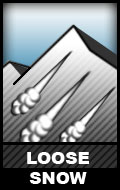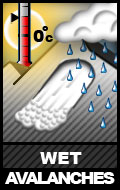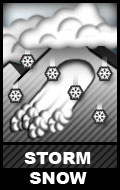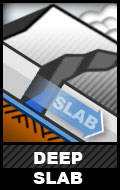Avalanche problems/concerns vary. Here we divide them into eight types according to their character. Below are the icons of avalanche problems/concerns used by the Anchorage Avalanche Center in advisories with descriptions and suggestions for managing each type of problem/concern.
The different avalanche problems/concerns have direct implications for the sort of terrain to favor or avoid, the likely size of avalanches, which observations are most useful, and how long the problem is likely to persist.
By clicking the icon or “learn more” link, you will be taken to another page with more in-depth details and information (including photos, how this type of problem/concern can hurt you, and more info on techniques to manage associated risks) in order to learn more about each type of problem/concern.
 Loose Dry Avalanches or “Sluffs”:
Loose Dry Avalanches or “Sluffs”:
- Are usually small, but may gain significant mass on long steep slopes
- Are typically limited to steep terrain (40+ degrees)
- Stabilize soon after a storm, usually within a few days
- Have the potential to “step-down” and trigger slab avalanches and deeper instabilities, especially if they gain significant volume as they descend
Management: Loose dry avalanches are best managed by avoiding terrain traps and steep slopes with hazards or exposure below, until the surface has stabilized. On large and steep slopes, occasionally move across the fall line to avoid being caught by your own sluff from above.
 Loose Wet Avalanches:
Loose Wet Avalanches:
- Are more powerful than loose dry avalanches due to their higher density
- Are often limited to sunny aspects and are especially likely to initiate in thin and/or rocky areas of the snowpack
- Are commonly confined to the warmest part of the day
- Have the potential to “step-down” and trigger slab avalanches and deeper instabilities as they descend
Management: Loose wet avalanches are best managed by avoiding start zones and avalanche paths when snow becomes moist from daytime warming, solar radiation, rain, or lack of an overnight freeze.
 Wet Slabs:
Wet Slabs:
- Involve wet layers in the snowpack, typically including deeper layers
- Tend to be large
- Occur when water forms or penetrates below the surface of the snowpack or a cohesive slab layer
Management: Wet slabs are best managed by avoiding start zones and avalanche paths when the snow becomes wet from daytime warming, solar radiation, rain, or lack of an overnight freeze.
 Cornice Falls:
Cornice Falls:
- Have the potential to trigger large slab avalanches on relatively stable slopes below if they fail
- Are often associated with recent wind loading and/or temperature changes (especially significant or prolonged warming)
- Can be triggered from ridges, sometimes breaking surprisingly far back onto ridge tops
Management: Cornices are best managed by approaching corniced ridges cautiously. Avoid traveling on or near overhanging cornices and limit time spent exposed to slopes below cornices, especially soon after wind events and during periods of warming temperatures.
 Wind Slabs:
Wind Slabs:
- Vary in size from small to medium
- Occur on lee and cross-loaded portions of slopes
- Are often limited to specific terrain features (lee or cross-loaded)
- Can often be recognized by changes in appearance of the snow surface, changes in surface snow hardness (density), hollow or drum-like sounds, and/or shooting cracks
- Winds that vary in strength and direction can produce complex and unexpected wind slab patterns
- Stabilize relatively soon, usually in a few days to a week
Management: Wind slabs are best managed by recognizing and avoiding areas where wind slabs may have formed, until they have stabilized.
 Storm Slabs:
Storm Slabs:
- Vary in size from small to very large
- May be soft slabs, fooling people into underestimating their hazardous potential
- Tend to occur on moderately steep slopes (35+ degrees)
- Occur in all terrain, but are larger and more frequent in the alpine
- Stabilize soon after a storm, usually within a few days
Management: Storm slabs are best managed by conservative terrain choices during and after storms until the storm snow has been given time to stabilize.
 Persistent Slabs:
Persistent Slabs:
- Slide on buried persistent weak layers, which often form during clear and cold periods and may involve deeper layers from weather events
- Vary in size from medium to very large and may cross terrain barriers to involve multiple slide paths
- May occur on very gentle terrain, even slopes of 20 degrees or less
- May be localized to specific elevations, aspects, or regions
- There are often no visible signs of persistent slab instability; lack of avalanche activity and lack of danger signs such as “red flags” or “bull’s eye clues” are NOT reliable indicators of stability
- An in-depth look beneath the snow surface, analyzing multiple layers and executing snowpit tests may aid in locating and understanding the nature of persistent slab problems and the persistent weak layers that cause them
- Stabilize slowly, tending to persist for several weeks or longer
- Often have dormant periods, becoming active again when the weather changes
- Are prone to lingering pockets of instability that persist long after most areas have stabilized
- Tend to release above the trigger, making it difficult to escape
- Are often triggered remotely from a long distance away
Management: Persistent slabs are best managed by very conservative terrain choices. Allow extra time for persistent slabs to stabilize and use a very cautious approach to new terrain. Be especially cautious after storms or during warming periods. When dealing with this sort of problem, assess the snowpack thoroughly and often.
 Deep Persistent Slabs:
Deep Persistent Slabs:
- Slide on deeply buried persistent weak layers, which often form during clear and cold periods or rain-on-snow events early in the season
- Involve thick, hard slabs – sometimes the entire snowpack.
- Tend to be very large, commonly crossing terrain barriers to involve multiple slide paths
- Tend to occur on larger slopes of moderate steepness, typically 30-40 degrees
- May be localized to specific elevations, aspects, or regions
- There are often no visible signs of deep slab instability; lack of avalanche activity and lack of danger signs such as “red flags” or “bull’s eye clues” are NOT reliable indicators of stability
- An in-depth look beneath the snow surface, analyzing deep layers and executing snowpit tests specifically designed for assessing deep instabilities (e.g. deep tap test) may aid in locating and understanding the nature of deep slab problems and the persistent weak layers that cause them
- Stabilize slowly if at all, persisting for months and often the entire season
- Dormant persistent deep slab instabilities often become active again when the weather changes, especially after storms or with warm spring weather
- Tend to release above the trigger, making it difficult to escape
- Are often triggered remotely from a long distance away
Management: Deep persistent slabs are best managed by very conservative terrain choices and a very cautious approach to new terrain. Be especially cautious after storms or during warming periods.
Be aware that the overall avalanche danger is a complex equation often involving more than one problem/concern at the same time.
